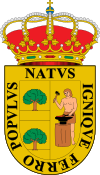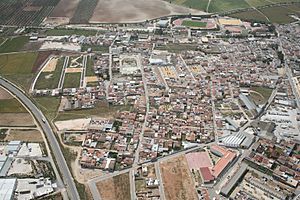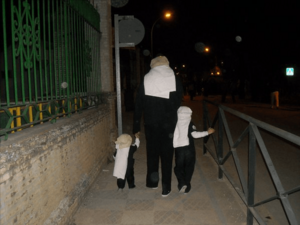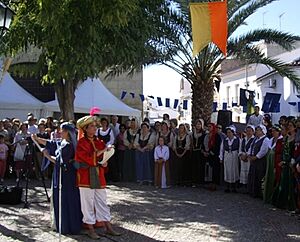Herrera, Seville facts for kids
Quick facts for kids
Herrera
|
|||
|---|---|---|---|
|
|||
| Country | Spain | ||
| A. community | Andalusia | ||
| Province | Seville | ||
| Municipality | Herrera | ||
| Area | |||
| • Total | 53,48 km2 (2,065 sq mi) | ||
| Elevation | 254 m (833 ft) | ||
| Population
(2018)
|
|||
| • Total | 6,485 | ||
| • Density | 122.03/km2 (316.1/sq mi) | ||
| Demonym(s) | Herrereños, herrereñas | ||
| Time zone | UTC+1 (CET) | ||
| • Summer (DST) | UTC+2 (CEST) | ||
| Website | www.herrera.es/ | ||
Herrera is a town in Spain, located in the province of Seville in Andalusia. About 6,484 people live here (as of 2018). The town covers an area of 53.48 square kilometers.
Herrera is about 120 kilometers from Seville, the capital city of the province. It's in a central spot in Andalusia. This means it's less than an hour away from big cities like Córdoba, Málaga, and Seville. Granada is just a bit further. The town's name comes from Latin words found on its flag's shield: Populus (village), Natus (born), Ignique (fire), and Ferro (and iron).
Contents
- Historical Places and Landmarks
- Fun Festivals and Celebrations
- Carnival: Dressing Up and Dancing
- Day of Andalusia: A Community Feast
- Passion Week: A Living Story
- San Marcos: Picnic Day!
- Pilgrimage in Honor of Our Lady of the Rosary of Fátima
- Corpus Christi: Decorated Streets
- Verbena de San Juan: Summer Fair Fun
- Fair of Herrera: A Grand Celebration
- Medieval Market: Step Back in Time
- See also
Historical Places and Landmarks
Municipal Museum: A Journey Through Time
This special museum in Andalusia shows old tools and materials. These items were used in medicine, surgery, and science long ago. You can see over 700 pieces, some from as far back as the second century B.C.
The museum also has more recent medical equipment. There are medicines, tools, and old books. Information panels explain everything clearly. Another room has a cool collection of fossils, stuffed animals, and insects. Plus, there's an archaeology section. Here you'll find ancient pottery, stone tools, and metal objects from different cultures in Andalusia.
Arab Fort of Alhonoz: The Last Frontier
The name Alhonoz means "the last stronghold." This fort was important during the time of the Arab rulers in Spain. It helped protect the roads leading to Córdoba.
The fort was part of a network of castles. These castles kept the roads safe from robbers. They also helped connect Córdoba with other cities and the Mediterranean Sea. This was very important for trade and defense.
Archaeological Discoveries in Herrera
Herrera has many ancient remains from different cultures. You can find traces of Iberian, Roman, and Arab people here. On the edge of town, there's a large Roman villa. This villa had marble pools and heating systems.
Seven big mosaics were found here, including one showing a boxing scene. Many paintings and marble pieces were also uncovered. Other important sites are near the Arroyo del Padrón and the Genil river. In total, Herrera has about ninety archaeological sites. These range from the Late Bronze Age to the Arab period.
Church Santiago El Mayor: A Historic Church
The Church Santiago El Mayor was first built in 1657. It was later updated in 1780. It has a large dome and a beautiful 18th-century Baroque altarpiece.
Inside, you can see several important statues. These include a crucifixion statue from around 1600. There's also a Virgin of Sorrows from the 18th century. Other famous artists like Castillo Lastruci and Francisco Buiza created some of the church's sculptures.
Church La Concepción: Built by the People
Work on the chapel of La Concepción started around 1732. It was finished and blessed by 1749. The people of Herrera helped pay for its construction.
The church has two main sections with arched ceilings. Inside, you'll find statues like the Heart of Jesus and the Immaculate. The Immaculate statue is from the 17th century and is quite special. There's also an old baptismal font from 1692.
Fireplace of Prograsa: A Symbol of Industry
The Fireplace of Prograsa is a more modern landmark. It was built in 1961 and stands over 27 meters tall. The bricks used to build it were made right in Herrera. A local builder, Francisco Muñoz Moreno, also known as "Curro Gigante," helped construct it.
This fireplace was part of an olive oil factory. The factory was very important for the town's economy. Over 200 people worked there. It even produced special oil that followed Jewish Law for food preparation. This building shows how Herrera grew industrially. It helped keep people in the town, as many had left before it was built. Today, the area around the fireplace is called Prograsa. It has homes, shops, and a park.
Fun Festivals and Celebrations
Carnival: Dressing Up and Dancing
Herrera loves to celebrate Carnival! People wear colorful costumes and parade through the streets. Locals watch from sidewalks, balconies, and windows. A special walkway is set up near the City Hall for participants to show off their outfits.
The day ends with a big dance where most of the town joins in. A week before the parade, a group called "Estudiantina" performs. They sing funny songs about things that happened in town and even national news.
Day of Andalusia: A Community Feast
This day is celebrated all over Andalusia. In Herrera, it's a huge gathering at the Place of Andalusia. About 1,700 people come together to enjoy local food and drinks. There are also musical performances that celebrate Herrera and Andalusia.
Passion Week: A Living Story
Semana Santa, or Passion Week, in Herrera is very special. It's unique because the procession isn't just a parade. It becomes a real-life play of the Bible story on the street. For example, you can see performances like "Arrest" and "Three Falls." It's a powerful and moving event for the community.
San Marcos: Picnic Day!
On April 25, for San Marcos, people in Herrera go out for picnics. They gather in different spots to enjoy the day. Everyone shares delicious food like gazpacho, tortillas, and paella.
Even though it's a local holiday for San Marcos, there isn't a procession with a statue of the saint. A fun tradition on this day is "Tie the Devil." People tie two "jaramagos" plants together. This symbolizes getting rid of all bad things.
Pilgrimage in Honor of Our Lady of the Rosary of Fátima
This pilgrimage is a yearly religious and cultural event. It happens on the second Sunday in May. It mixes Catholic traditions with local celebrations.
The day starts with about a hundred decorated floats gathering in the town square. People pray the Rosary and attend a special Mass. Afterward, the statue of Our Lady of the Rosary of Fátima is placed on a carriage. It then begins its journey to "The Carrizosas" exhibition grounds.
People travel to "The Carrizosas" in many ways. Some walk, others ride in tractor-pulled floats or horse-drawn carriages. Horse riders also escort the procession. Around six thousand people gather at the grounds. When the Virgin's statue arrives, bells ring from a chapel built just for this event.
At "The Carrizosas," the celebration continues with traditional singing and dancing. People gather socially and enjoy local foods. You can taste gazpacho, picadillo, paella, and grilled meats. This pilgrimage is one of Herrera's most popular events for visitors.
Corpus Christi: Decorated Streets
Corpus Christi is celebrated in June. A highlight is when the procession passes through Roldan Street. This street is beautifully decorated with Catholic paintings for the occasion.
Verbena de San Juan: Summer Fair Fun
The Verbena de San Juan takes place on the second-to-last weekend of June. The goal is to have it close to the actual day of San Juan. The Municipal Park "Luis de la Señá María" becomes a lively fairground. Its trees, gardens, and sandy streets attract many visitors.
Public and private booths welcome everyone to enjoy the "Velá de San Juan." Carriages, horses, rides, and performances fill the evening with a festive mood.
Fair of Herrera: A Grand Celebration
The Fair of Herrera always ends on the second Sunday of August. It starts on the Wednesday of that week. The "Pedro de la Timotea" Flamenco Festival kicks off the fair. Famous singers and dancers perform in Herrera.
Many people who have moved away from Herrera come back for this fair. The Municipal Park, with its leafy trees and gardens, is the perfect spot. Over sixty booths, both private and public, are set up. Even with the midday heat, people come to enjoy the atmosphere. They have handmade gazpacho and local tapas before a delicious meal.
As the years pass, the fair becomes even more lively during the day. People enjoy horse ribbon races and preparing good food. They visit booths to share local wine. In the evening, the cooler temperatures are perfect for walks. You can browse stalls and enjoy the various rides. Young people love their fair, especially the youth booth. After a night of dancing, many people go to a bar for hot chocolate and "jeringos" (a type of churro) to regain energy. The fair ends on Sunday with a fireworks display lighting up the sky.
Medieval Market: Step Back in Time
The old part of town, called Barribalto, transforms into a Medieval Market. This happens during one weekend in October. Locals take part by setting up businesses or just enjoying the fun. Around the Church Santiago El Mayor, you'll find taverns, inns, and craft stalls. These make visitors feel like they've traveled back centuries.
Activities at the Medieval Market include:
- Handicraft exhibitions by local artists.
- Parades and tasting of special drinks.
- Craft workshops.
- Firework displays.
- Juggling, theater, and belly dancing.
- Activities for children, like storytelling and face painting.
See also
 In Spanish: Herrera (Sevilla) para niños
In Spanish: Herrera (Sevilla) para niños






